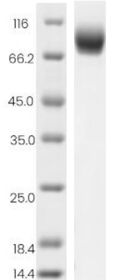Human CD274 Protein, mFc Tag
-
产品编号
KMP2420
-
别名
程序性死亡蛋白配体-1, programmed cell death 1 ligand 1, CD274
-
规格
- 50ug
- 100ug
- 200ug
| Catalog Number | KMP2420 |
| Alias | 程序性死亡蛋白配体-1, programmed cell death 1 ligand 1, CD274 |
| Size | 50ug, 100ug, 200ug |
| Product Description | The Human CD274 Protein(KMP2420) is produced in HEK293 Cells and the target gene encoding Phe19-Thr239 is expressed with a mFc tag at the C-terminus. |
| Molecular Name | CD274 |
| Product Introduction | CD274(PD-L1):免疫球蛋白超家族(IgSF)成员,通过跨膜形式参与免疫细胞功能调控。 |
| Molecular Weight | 25.3 kDa |
| Expression System | HEK293 Cells |
| Species | Human |
| Purity | >95% |
| SDS-PAGE |  |
| Purification | Affinity Purification |
| Uniprot ID | Q9NX76 |
| Storage Condition | Aliquot and store at -20℃ to -80℃. Avoid repeated freezing and thawing cycles. |
| Formulation | PBS, pH7.4 |
| Shipping Condition | In general, the proteins are provided as lyophilized powder which are shipped at ambient temperature. They are shipped out in dry ice if supplied in liquid form. |
| Background | CD274, also known as B7-H1 or programmed death ligand 1(PD-L1), is a 40 kD type I transmembrane protein and a member of the B7 family within the immunoglobulin receptor superfamily. Programmed death-1 ligand-1(PD-L1, CD274, B7-H1) has been identified as the ligand for the immunoinhibitory receptor programmed death-1(PD1/PDCD1) and has been demonstrated to play a role in the regulation of immune responses and peripheral tolerance. By binding to PD1 on activated T-cells and B-cells, PD-L1 may inhibit ongoing T-cell responses by inducing apoptosis and arresting cell-cycle progression. Accordingly, it leads to growth of immunogenic tumor growth by increasing apoptosis of antigen specific T cells and may contribute to immune evasion by cancers. PD-L1 thus is regarded as promising therapeutic target for human autoimmune disease and malignant cancers. |
| Endotoxin | <1.0 EU/ug determined by the LAL method |
| Product Declaration | 该产品仅供科研使用,不可直接用于人体或注射。 |
蛋白可以在-80°C下储存以便长期保存。应分装并避免冻融循环,以保持蛋白的稳定性。
可以通过优化质粒设计、使用高效转染试剂、优化细胞培养条件以及使用蛋白折叠伴侣或密码子优化来提高蛋白表达效率。





 0
0
